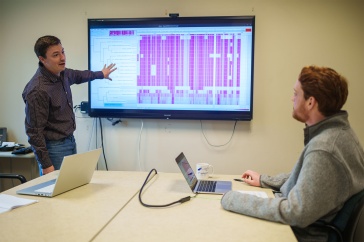
Researchers deployed the low-cost sensors on the Oyster River. Credit: Across the Atlantic.
Researchers with the University of New Hampshire have been recognized by the U.S. Environmental Protection Agency for their innovative efforts in using low-cost technology to monitor water quality in manmade reservoirs.
“To address the challenges of today and the future, we need innovative thinkers at the global- and local-level,” said Principal Deputy Assistant Administrator for Science and EPA Science Advisor Jennifer Orme-Zavaleta. “We commend the ‘challenge’ winners for identifying creative ways to use low-cost tools to understand our resources and better inform nutrient management decisions.”
New Hampshire Agricultural Experiment Station researcher Wilfred Wollheim, associate professor of natural resources and environment, and his team at the UNH Water Systems Analysis Group were one of three winners of the EPA’s Nutrient Sensor Action Challenge. The team, including research scientist Gopal Mulukutla, and natural resources graduate student Eliza Balch, demonstrated how data from low-cost water quality monitoring sensors can be used to inform local nutrient management decisions associated with the removal of manmade dams that create reservoirs.
Wollheim and his collaborators deployed the sensors to assess amount and timing of nitrate entering and leaving reservoirs. Nitrate is a compound that is formed naturally when nitrogen combines with oxygen or ozone. Nitrogen is essential for all living things, but high levels of nitrate in drinking water can be dangerous to health, especially for infants and pregnant women.

“Manmade reservoirs can contribute a substantial amount of watershed nitrogen retention, but the capacity to retain nitrogen in smaller coastal reservoirs more typical of New England, especially during storms, remains an unanswered question. It is important to answer this question because many of the dams that create these reservoirs either are being removed, because they are impaired or no longer serve their original purpose. This could affect nitrogen exports to estuaries, many of which are already nitrogen impaired,” Wollheim said.
Researchers deployed sensors in two coastal reservoirs of New Hampshire, one with a dam that is expected to be removed this year and the other with a dam that is under discussion for removal. The goals of the research were to:
- demonstrate that sensors can be used to identify sources and timing of nonpoint nitrogen that should be prioritized for mitigation.
- identify whether small New England reservoirs are effective at retaining nitrogen and how this varies across flow conditions.
- inform those interested in purchasing low-cost nutrient sensors whether they are suitable to be deployed in natural streams and rivers.
Based on the research results, the scientists recommend the following to help control nonpoint nitrate in the landscape:
- Work with catchment residents to reduce the amount of fertilizer they apply to lawns and ensure that septic systems are well maintained and well-functioning.
- Restore riparian areas that intercept groundwater high in nitrate. Riparian zones are effective at removing nitrogen so making sure these are protected and/or restored will lower nitrate concentrations.
- Introduce storm water detention ponds that are managed to enhance nitrogen retention.
- Consider the role of reservoirs when dam removal decisions are under consideration.
- Continue to invest in improving the technology of low-cost nutrient sensors.
“Low-cost nutrient sensors must be part of the future of both research and management regarding nutrients. As nitrogen pollution continues to accelerate, widespread deployments of sensors from headwaters to large rivers, in multiple types of water bodies, will be needed to help us better understand sources from the landscape, and account for the role of retention within river networks,” Wollheim said.
This material is based upon work supported by the NH Agricultural Experiment Station, through joint funding of the National Institute of Food and Agriculture, U.S. Department of Agriculture, under award number 0225006, and the state of New Hampshire. This research also was supported by NH Sea Grant, Natural Resources and Conservation Service, and Real Tech Inc.
Founded in 1887, the NH Agricultural Experiment Station at the UNH College of Life Sciences and Agriculture is UNH’s original research center and an elemental component of New Hampshire's land-grant university heritage and mission. We steward federal and state funding, including support from the USDA National Institute of Food and Agriculture, to provide unbiased and objective research concerning diverse aspects of sustainable agriculture and foods, aquaculture, forest management, and related wildlife, natural resources and rural community topics. We maintain the Woodman and Kingman agronomy and horticultural research farms, the Macfarlane Research Greenhouses, the Fairchild Dairy Teaching and Research Center, and the Organic Dairy Research Farm. Additional properties also provide forage, forests and woodlands in direct support to research, teaching, and outreach.
-
Written By:
Lori Wright, '06G | NH Agricultural Experiment Station | lori.wright@unh.edu | 16038621452

















































